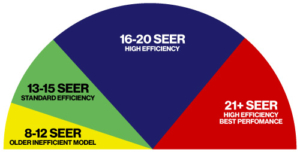
When it comes to keeping your home cool and comfortable during the hot months, your air conditioning system plays a critical role. But how do you know if your AC is energy efficient or if it’s costing you more than it should in utility bills? That’s where the SEER rating comes in.
At 4 Winds AC and Heating, we believe that informed homeowners make better decisions, so let’s break down what a SEER rating is and why it should matter to you.
What Does SEER Stand For?
SEER stands for Seasonal Energy Efficiency Ratio. It’s a measurement of an air conditioner’s or heat pump’s cooling efficiency over a typical cooling season. In simple terms, it tells you how much cooling you get for each unit of energy consumed.
The higher the SEER rating, the more energy efficient the system is.
How Is SEER Calculated?
SEER is calculated by dividing the total cooling output (in BTUs) over a cooling season by the total electrical energy input (in watt-hours) during the same period. The result is a single number that gives you an efficiency snapshot.
For example, a unit with a SEER of 16 is more efficient than one with a SEER of 13 because it provides more cooling for the same amount of electricity.
Why Does SEER Rating Matter?
Lower Energy Bills
The most immediate benefit of a higher SEER rating is reduced energy consumption. A more efficient system requires less power to cool your home, which means you’ll see savings on your monthly utility bills.
Environmental Impact
Energy efficient systems reduce your carbon footprint. By choosing a unit with a higher SEER rating, you’re doing your part to conserve energy and help protect the environment.
Comfort and Performance
Modern HVAC systems with higher SEER ratings often come with features that improve overall performance, such as variable speed compressors and smart thermostats. This means more consistent temperatures, quieter operation, and better humidity control.
Rebates and Incentives
Many utility companies and local governments offer rebates or incentives for upgrading to a high SEER unit. These can help offset the upfront cost of a new system.
Future Proofing Your Home
As efficiency standards rise, homes with outdated systems may lose value. Investing in a high SEER HVAC system can make your property more attractive to future buyers.
What SEER Rating Should You Look For?
In many regions of the U.S., the minimum required SEER rating for new central air conditioners is 14 or 15, depending on the climate zone. However, systems with SEER ratings of 16 to 21+ offer the best combination of energy savings and performance.
We typically recommend choosing the highest SEER rating that fits within your budget and meets your home’s needs.
Is a Higher SEER Always Better?
While a higher SEER rating means greater efficiency, it’s not always necessary to get the highest number available. Factors like climate, how often you use your system, and your home’s insulation can all influence what SEER rating makes the most sense for you.
That’s why it’s best to consult with an HVAC professional to determine the right fit.
Let’s Help You Choose the Right System
At 4 Winds AC and Heating, we specialize in helping homeowners select energy efficient systems that balance performance, comfort, and budget. If you’re considering a new air conditioner or heat pump, or just want to learn more about SEER ratings, we’re here to help.
Contact us today for a free consultation or to schedule a home energy assessmet.
Stay cool, stay efficient with 4 Winds AC and Heating.

Leave A Comment